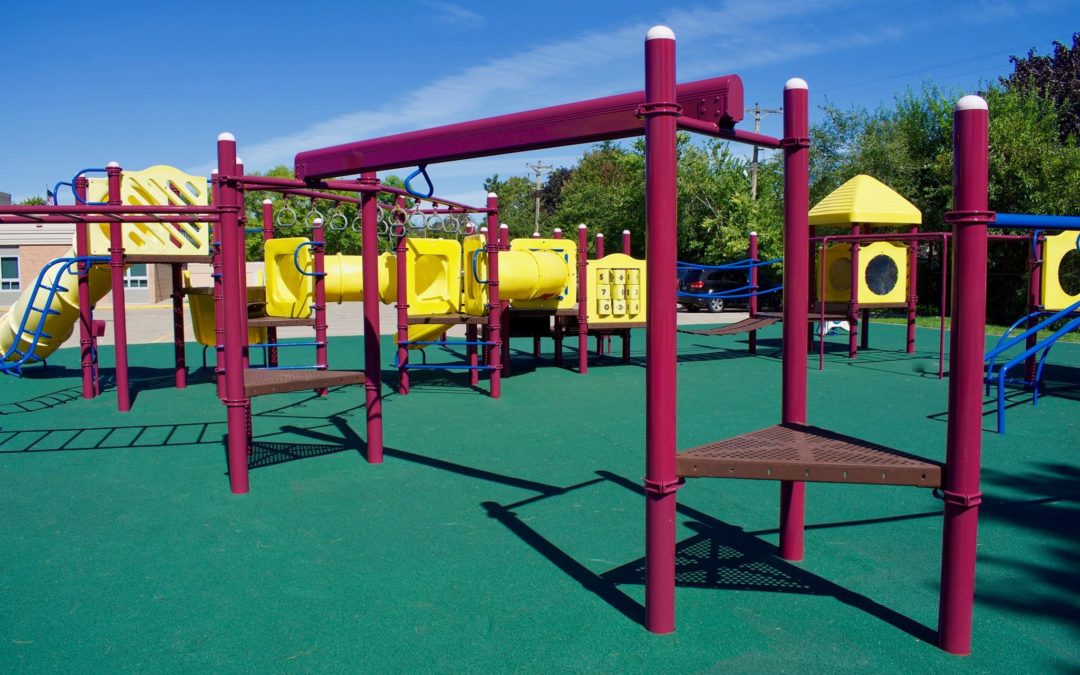As a playground repair company, we’ve come across a lot of different playgrounds of various lifespans, degrees of traffic, and levels of regular maintenance. No matter the different uses, locations, or amount of care that is put into your playground, the equipment and parts will inevitably become worn or damaged. From broken swings to chipped paint, in order to maintain your playground’s aesthetic, safety, and longevity, you will need to replace or repair your playground equipment along the way.
While we know parks, schools, and other commercial organizations want to keep their playgrounds safe and beautiful, other factors go into maintaining a playground including budgets, resources, and time. When assessing equipment, we prioritize these factors while still maintaining playground compliance.
To help you determine if you need to repair or replace your playground equipment, here are the strategies we use for determining when to repair vs replace. This guide will cover:
- Advantages and disadvantages of equipment repair
- Advantages and disadvantages of equipment replacement
- Situations that call for repair
- Situations that call for replacement
Why choose playground repair over replacement?
Advantages of Playground Equipment Repair
- Typically repairing is more cost-effective than purchasing new equipment
- It is a more sustainable solution rather than discarding salvageable materials
- Maintains the community’s or school’s sentimental value for the playground if there is history associated with the playground
Disadvantages of Playground Equipment Repair
- As the playground and equipment ages, the annual maintenance costs increase
- Playground compliance with safety regulations can become increasingly more difficult to uphold – as regulations change, older equipment may no longer be compliant
- Manufacturers are allowed to stop making parts for equipment 15 years or older, so procuring repair parts becomes more challenging and expensive
Why choose playground replacement over repairing equipment?
Advantages of Playground Equipment Replacement
- Creates community and school excitement to receive new and fun equipment
- Complies with updated safety regulations
- New equipment is often designed to be more inclusive and ADA compliant
- Annual maintenance costs will typically decrease
Disadvantages of Playground Equipment Replacement
- Typically it costs more to buy new equipment than replacement parts
- Lead times can be up to 10-16 weeks before receiving parts causing your playground to be unavailable for a few weeks
- If you have solid surfacing, such as poured in place, you will need to replace the surfacing when installing new equipment which can be an expensive project
Playground Maintenance Situations that Require Repair
Below are common situations when playground equipment repair will be the right option.
- Available parts – if you can easily purchase repair parts or products, it will save money to maintain your existing equipment
- Chipping paint – if the paint or exterior of the playground equipment is chipping or has marks, a new paint job will refresh the aesthetic of the playground
- Minimal issues – if there are only a few issues with some of the equipment, focus on repairing the parts through regular maintenance checks
- Solid surfacing – if your playground has solid surfacing, such as poured in place, it is typically more cost-effective to repair existing playground equipment than replacing equipment since it requires redoing the surfacing
Playground Maintenance Situations that Require Replacement
Below are common situations or types of equipment when replacing playground equipment will be the right option.
- Age of the playground – if your playground is 20+ years old, we may advise replacing the equipment
- High traffic – if your playground is used often and by many children, you will likely need to replace equipment sooner due to high traffic wear and tear
- High vandalism – if your playground is often vandalized, the destruction or carved graffiti will often require more extensive replacement to fix
- Unavailable parts – if you are unable to find playground repair parts for your equipment, you will need to buy a more recent version of the equipment
- Decking – if more than 50% of the decking equipment needs to be replaced, it is often less expensive to replace the entire structure
- Plastic components – if repair parts for plastic playground equipment are not available because companies stopped manufacturing them, you will need to replace the equipment since fabricating the parts can be very challenging
- Moving components – if moving equipment (bridges, spinners) are showing signs of damage, it is important to replace these parts before they fail
- Non-compliant equipment – if the equipment is no longer safety or ADA compliant, replacing events with ensuring your playground remains compliant with changing regulations
The Ultimate Solution: Start a Playground Maintenance Plan
Deciding when to repair or replace playground equipment takes a lot into consideration, as covered above. At SafetyFirst, we recommend that parks, schools, or other facilities that own playgrounds implement a regular playground maintenance plan to proactively identify equipment repairs and spread out costs. Repairing or replacing a bunch of equipment can be a very expensive and time-consuming process. A playground maintenance plan allows your grounds or maintenance crew to discover existing or potential issues before they become larger problems.
We recommend starting with an annual maintenance assessment and depending on playground traffic and location, you can increase the frequency of maintenance. To help out, we’ve put together a playground maintenance checklist of what you should look for when conducting your assessment!
If you have questions about repairing or replacing your equipment or need assistance with the projects, please contact our team. We look forward to working with you!

